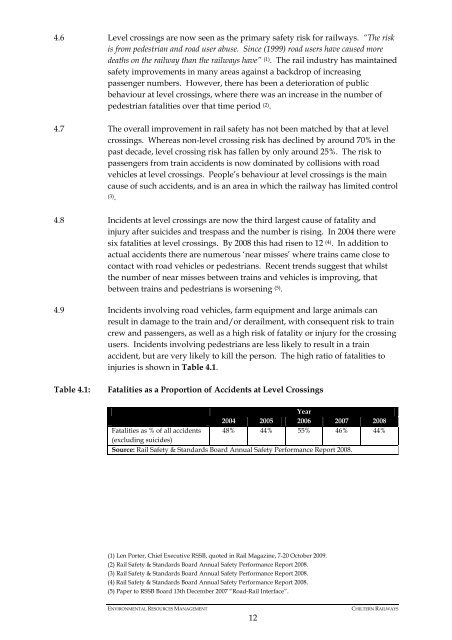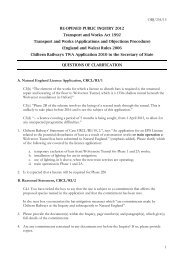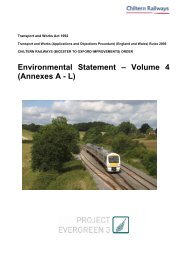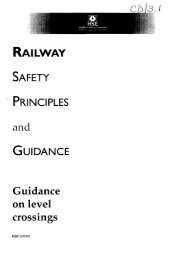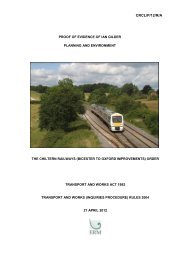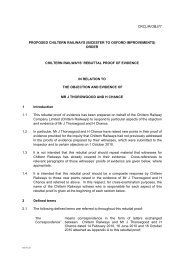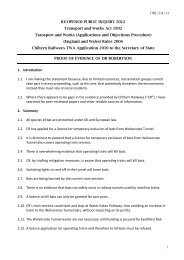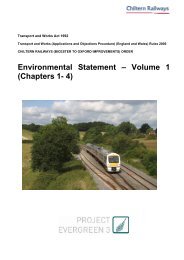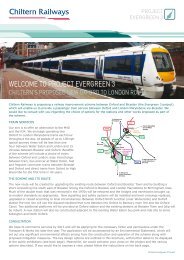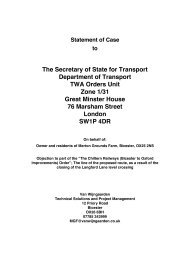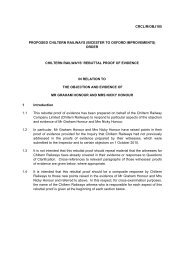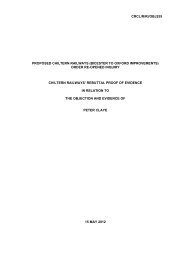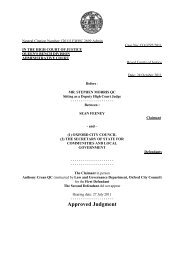Public Rights of Way Report - Chiltern Evergreen3
Public Rights of Way Report - Chiltern Evergreen3
Public Rights of Way Report - Chiltern Evergreen3
You also want an ePaper? Increase the reach of your titles
YUMPU automatically turns print PDFs into web optimized ePapers that Google loves.
4.6 Level crossings are now seen as the primary safety risk for railways. “The riskis from pedestrian and road user abuse. Since (1999) road users have caused moredeaths on the railway than the railways have” (1) . The rail industry has maintainedsafety improvements in many areas against a backdrop <strong>of</strong> increasingpassenger numbers. However, there has been a deterioration <strong>of</strong> publicbehaviour at level crossings, where there was an increase in the number <strong>of</strong>pedestrian fatalities over that time period (2) .4.7 The overall improvement in rail safety has not been matched by that at levelcrossings. Whereas non-level crossing risk has declined by around 70% in thepast decade, level crossing risk has fallen by only around 25%. The risk topassengers from train accidents is now dominated by collisions with roadvehicles at level crossings. People’s behaviour at level crossings is the maincause <strong>of</strong> such accidents, and is an area in which the railway has limited control(3).4.8 Incidents at level crossings are now the third largest cause <strong>of</strong> fatality andinjury after suicides and trespass and the number is rising. In 2004 there weresix fatalities at level crossings. By 2008 this had risen to 12 (4) . In addition toactual accidents there are numerous ‘near misses’ where trains came close tocontact with road vehicles or pedestrians. Recent trends suggest that whilstthe number <strong>of</strong> near misses between trains and vehicles is improving, thatbetween trains and pedestrians is worsening (5) .4.9 Incidents involving road vehicles, farm equipment and large animals canresult in damage to the train and/or derailment, with consequent risk to traincrew and passengers, as well as a high risk <strong>of</strong> fatality or injury for the crossingusers. Incidents involving pedestrians are less likely to result in a trainaccident, but are very likely to kill the person. The high ratio <strong>of</strong> fatalities toinjuries is shown in Table 4.1.Table 4.1:Fatalities as a Proportion <strong>of</strong> Accidents at Level CrossingsFatalities as % <strong>of</strong> all accidents(excluding suicides)Year2004 2005 2006 2007 200848% 44% 55% 46% 44%Source: Rail Safety & Standards Board Annual Safety Performance <strong>Report</strong> 2008.(1) Len Porter, Chief Executive RSSB, quoted in Rail Magazine, 7-20 October 2009.(2) Rail Safety & Standards Board Annual Safety Performance <strong>Report</strong> 2008.(3) Rail Safety & Standards Board Annual Safety Performance <strong>Report</strong> 2008.(4) Rail Safety & Standards Board Annual Safety Performance <strong>Report</strong> 2008.(5) Paper to RSSB Board 13th December 2007 “Road-Rail Interface”.ENVIRONMENTAL RESOURCES MANAGEMENT12CHILTERN RAILWAYS


